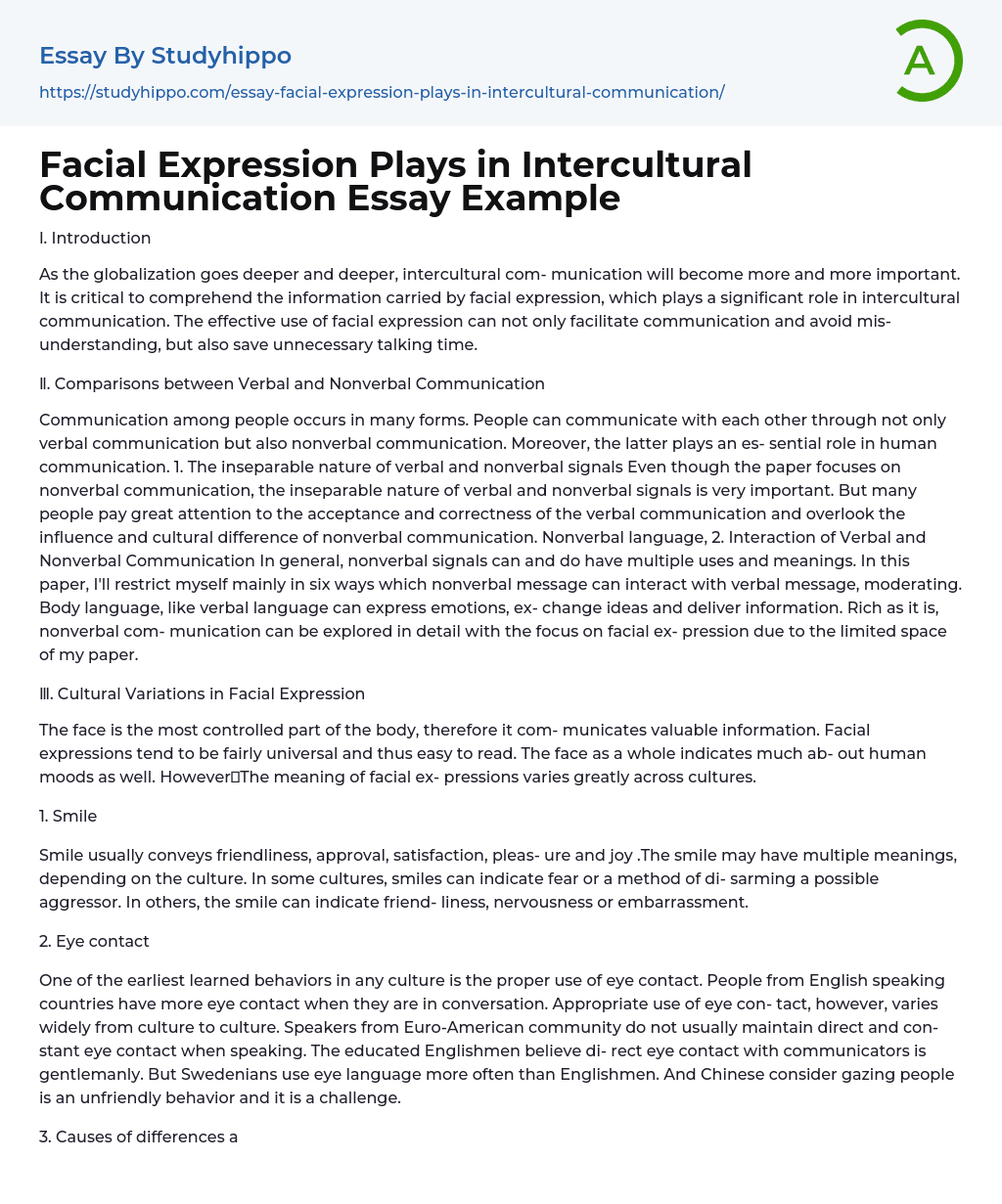

Facial Expression Plays in Intercultural Communication Essay Example
Ⅰ. Introduction
As the globalization goes deeper and deeper, intercultural com- munication will become more and more important. It is critical to comprehend the information carried by facial expression, which plays a significant role in intercultural communication. The effective use of facial expression can not only facilitate communication and avoid mis- understanding, but also save unnecessary talking time.
Ⅱ. Comparisons between Verbal and Nonverbal Communication
Communication among people occurs in many forms. People can communicate with each other through not only verbal communication but also nonverbal communication. Moreover, the latter plays an es- sential role in human communication. 1. The inseparable nature of verbal and nonverbal signals Even though the paper focuses on nonverbal communication, the inseparable nature of verbal and nonverbal s
...ignals is very important. But many people pay great attention to the acceptance and correctness of the verbal communication and overlook the influence and cultural difference of nonverbal communication. Nonverbal language, 2. Interaction of Verbal and Nonverbal Communication In general, nonverbal signals can and do have multiple uses and meanings. In this paper, I'll restrict myself mainly in six ways which nonverbal message can interact with verbal message, moderating. Body language, like verbal language can express emotions, ex- change ideas and deliver information. Rich as it is, nonverbal com- munication can be explored in detail with the focus on facial ex- pression due to the limited space of my paper.
Ⅲ. Cultural Variations in Facial Expression
The face is the most controlled part of the body, therefore it com- municates valuable information. Facial expressions tend to be fairly universal and thus easy to read. The fac
as a whole indicates much ab- out human moods as well. However,The meaning of facial ex- pressions varies greatly across cultures.
1. Smile
Smile usually conveys friendliness, approval, satisfaction, pleas- ure and joy .The smile may have multiple meanings, depending on the culture. In some cultures, smiles can indicate fear or a method of di- sarming a possible aggressor. In others, the smile can indicate friend- liness, nervousness or embarrassment.
2. Eye contact
One of the earliest learned behaviors in any culture is the proper use of eye contact. People from English speaking countries have more eye contact when they are in conversation. Appropriate use of eye con- tact, however, varies widely from culture to culture. Speakers from Euro-American community do not usually maintain direct and con- stant eye contact when speaking. The educated Englishmen believe di- rect eye contact with communicators is gentlemanly. But Swedenians use eye language more often than Englishmen. And Chinese consider gazing people is an unfriendly behavior and it is a challenge.
3. Causes of differences and similarities
Just as verbal language varies from culture to culture, so does body language. Some expressions such as fear, anger, sadness, disgust, and interest are fairly universal. However, cultures tend to develop the- ir own communication styles. Apart from cultural elements, there are still some other factors that cause the differences. Such as gender, so- cial hierarchy, belief, and geographical difference, etc.
4. The advantage of knowing the knowledge
Facial expressions are important because of its role in the total communication system, the tremendous quantity of informational cues it gives in any particular situation, and
its use in fundamental areas of our daily life. Understanding the different use of facial expression in different cultures is extremely important in our multicultural world to- day. By knowing the knowledge of the varied meaning of facial ex- pressions in different cultures, we can communicate with foreigners effectively and avoid misunderstanding in the intercultural communi- cation process.
Ⅳ. Conclusion
Driven by the rapid globalization, intercultural communication becomes increasingly important. We must get very familiar with the information and grasp the skills needed in the intercultural communi- cation. This thesis is written to provide essential information and prac- tical examples about important aspects of facial expressions, from which we acquire different cultural knowledge. Having known the im- portant role facial expression plays in communication, the cultural dif- ferences and similarities, and the advantage of knowing the informa- tion, we will be more observant in the future communication and com- municate more effectively.
- Pressure essays
- Confidence essays
- Disgrace essays
- Lost essays
- Harmony essays
- Fairness essays
- Sarcasm essays
- Respect essays
- Responsibility essays
- Empathy essays
- Suffering essays
- Suspense essays
- Fear essays
- Feeling essays
- Loneliness essays
- Ambition essays
- Tolerance essays
- Hope essays
- Inspiration essays
- Kindness essays
- Shame essays
- Desire essays
- Doubt essays
- Grief essays
- Hate essays
- Laughter essays
- Passion essays
- Pride essays
- Forgiveness essays
- Happiness essays
- Humanity essays
- Loyalty essays
- Guilt essays
- Honesty essays
- Betrayal essays
- Need essays
- Boredom essays
- Courage essays
- Regret essays
- Anger essays
- Honor essays
- Honesty Is The Best Policy essays
- Hamlet essays
- Iago essays
- Macbeth essays
- Othello essays
- The Merchant Of Venice essays
- A raisin in the sun essays
- The glass menagerie essays
- Hedda Gabler essays



